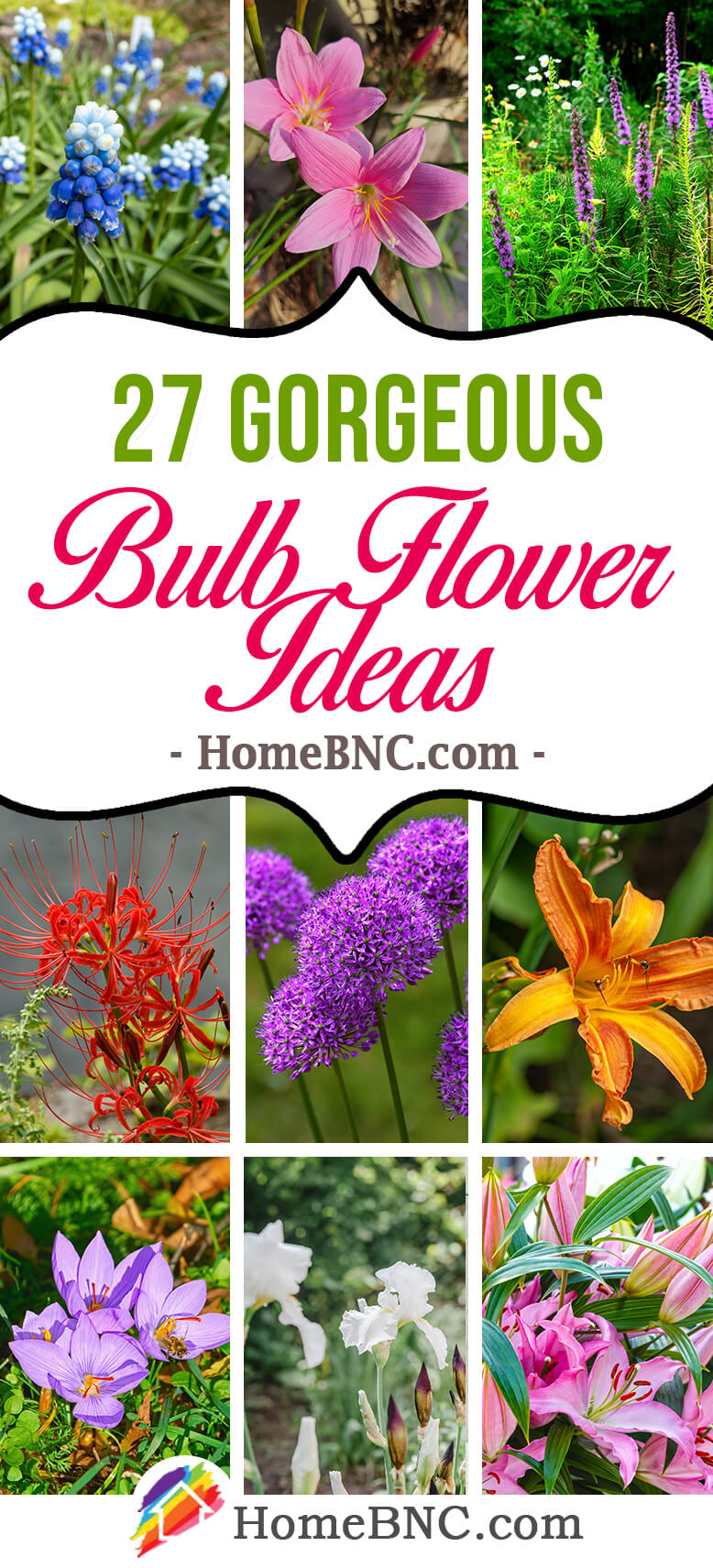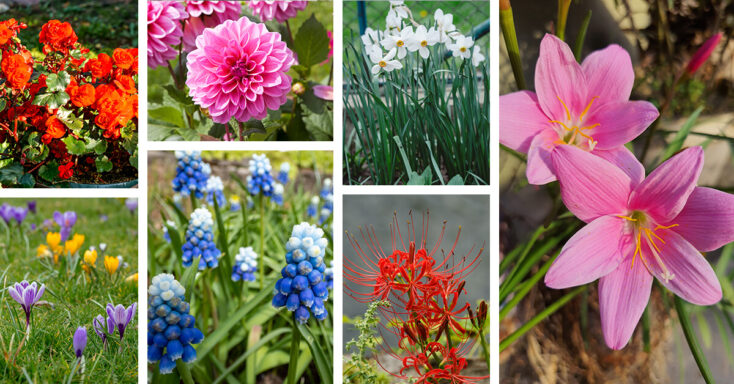Bulb flowers are perfect for anyone who wants to create a tropical feel without spending all day gardening because they are plants that you can grow indoors. They have a long flowering period and come in many colors, shapes, and sizes.
27 Eye-catching Bulb Flowers for Every Garden
They are an easy way to add color to your home or office without the hassle of caring for a plant. They also need little maintenance, which makes them great for people who don’t have time for gardening but still want some greenery in their home or office. They are very versatile and can be used for decorations, weddings, parties, bouquets, centerpieces, and much more.
1. Grape Hyacinth (Muscari Aucheri)
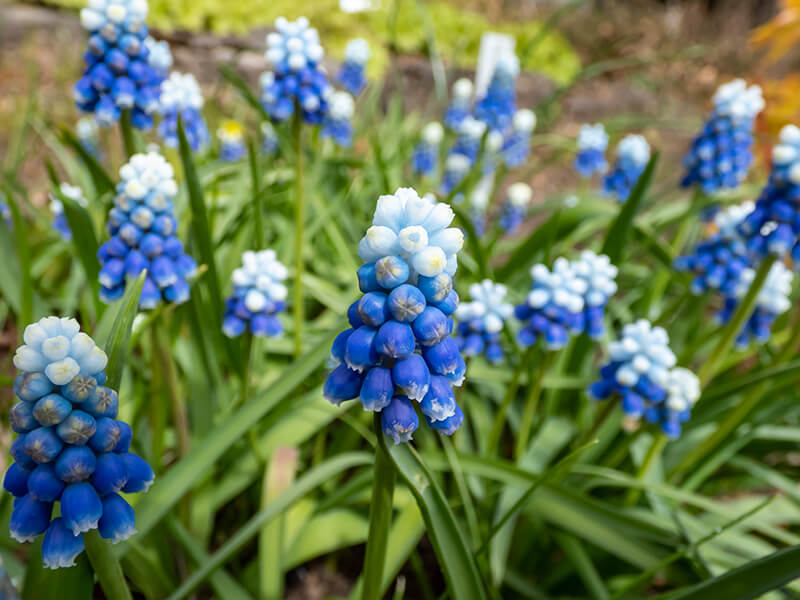
- 🔮 Symbolism: Confidence, mystery
- 💧 Water needs: Average to dry
- 🪴 Soil needs: Average, well-draining
- 🌍 Growing zones: 3 to 9
- ☀️ Light needs: Full sun to partial sun
- 🌱 Blooming season: Mid to late spring
Grape hyacinth is a perennial herbaceous plant in the grape family. It has a large, showy, bell-shaped flower with a two-lipped corona. The flowers are typically blue but can be white or purple.
Grape hyacinths are native to Europe and North Africa and have been introduced to other parts of the world as an ornamental bulb flower plant. They grow best in full sun and moist but well-drained soil rich in organic matter.
The annual flowering vine reaches 10 ft high with leaves up to 2 ft long, producing tubular flowers 0.8 to 1.2 inches long and 0.4 to 0.6 inches wide.
2. Emory Paul Dinner Plate Dahlia (Dinner Plate Dahlia Emory Paul)
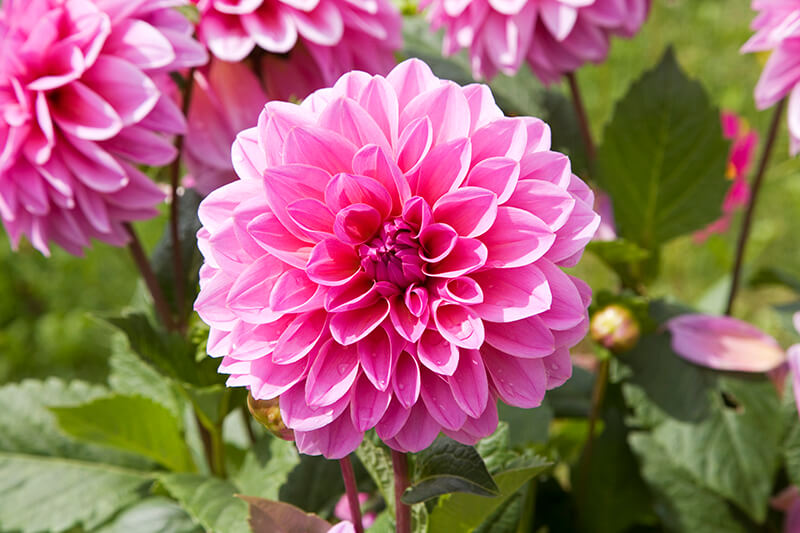
- 🔮 Symbolism: Elegance, dignity
- 💧 Water needs: Average
- 🪴 Soil needs: Sandy, loamy, acidic
- 🌍 Growing zones: 2 to 10
- ☀️ Light needs: Full sun
- 🌱 Blooming season: Mid summer
The Emory Paul Dinner Plate Dahlia is a flower named after its creator, Emory Paul. It was created by crossing the Dahlia with the African Violet in 1876.
It is considered to be one of the most beautiful flowers in existence. They are also known as “The Godfather of all Flowers.”
The dahlia can grow up to 8 inches and are available in a variety of colors, including white, yellow, red, blue, purple, and green.
3. Pheasant’s Eye (Narcissus Poeticus)
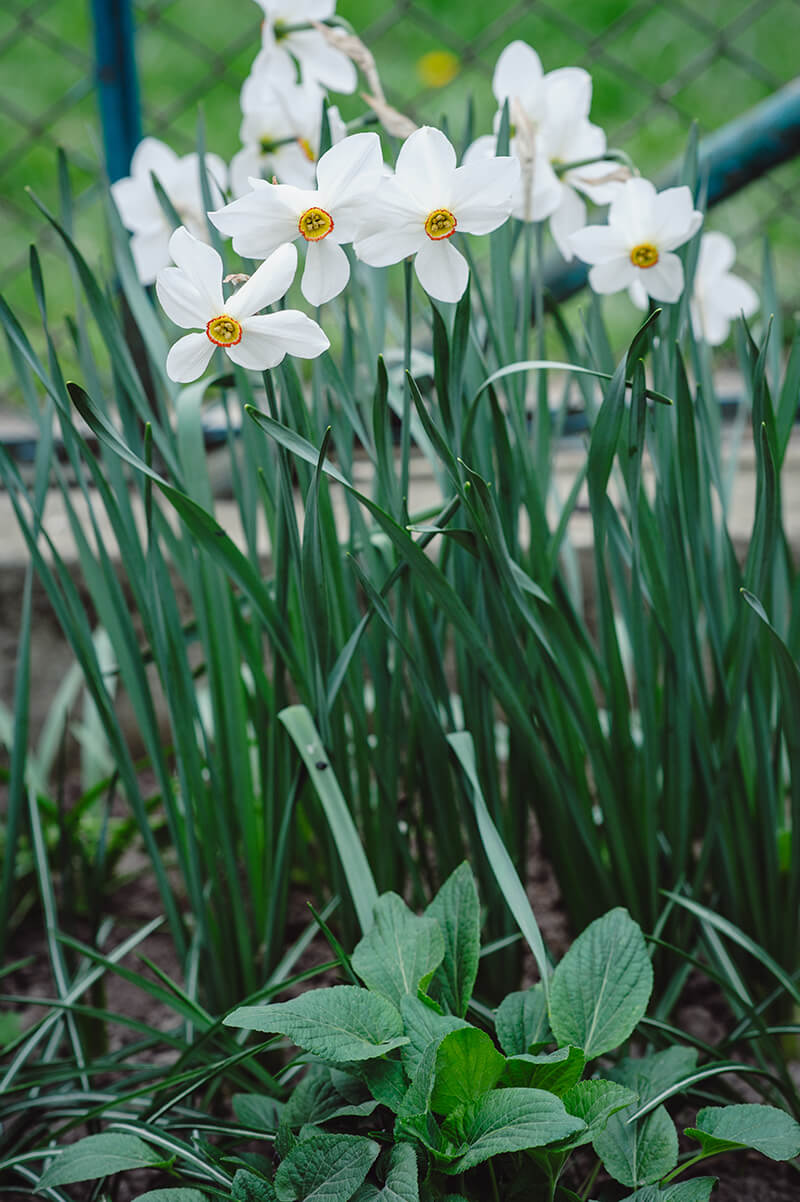
- 🔮 Symbolism: Rebirth, renewal
- 💧 Water needs: Low
- 🪴 Soil needs: Any
- 🌍 Growing zones: 6 to 8
- ☀️ Light needs: Half day of winter sun
- 🌱 Blooming season: Late spring
Daffodils are one of the most popular flowers in the world. They are also known as narcissus poeticus.
Daffodils have a long history and have been grown for thousands of years. There are many legends about Daffodils, but all of them share a common theme – that Daffodil brings happiness, joy, and hope to those who see them.
Daffodils were used in ancient cultures as symbols of life and rebirth. They were used in rituals to celebrate springtime, weddings, and funerals.
4. Crimson Flag (Hesperantha Coccinea)
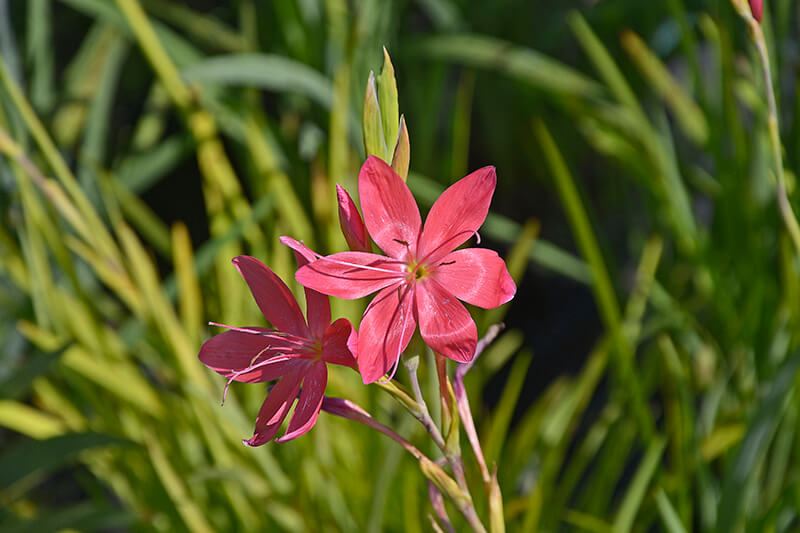
- 🔮 Symbolism: Completion
- 💧 Water needs: Average to high
- 🪴 Soil needs: Moist
- 🌍 Growing zones: 7 to 9
- ☀️ Light needs: Full sun to partial shade
- 🌱 Blooming season: Late Summer
Crimson flag is a plant in the genus Hesperantha. It is native to South Africa and Namibia.
The crimson flag is a perennial herbaceous plant growing from a thick rootstock. It has thin, fleshy leaves and stems that grow up to about 1 m in height. The flowers are red and about 5 inches across, with five petals fused together at the base into a tube. The fruit is an 8-angled seedpod up to 4.7 inches long and 1.6 inches wide, containing many small seeds with wings that enable them to be dispersed by wind or water.
The crimson flag has been used as an ornamental plant since 1885, when it was first introduced into Europe as an alternative to Snapdragon (Antirrhinum majus).
5. Pickwick Dutch Crocus (Crocus Vernus Pickwick)

- 🔮 Symbolism: Youth, rebirth
- 💧 Water needs: Average to dry
- 🪴 Soil needs: Average, well-draining
- 🌍 Growing zones: 3 to 9
- ☀️ Light needs: Full sun to partial shade
- 🌱 Blooming season: Early spring
Crocus is a flower that is known to have medicinal properties. It contains many antioxidants and anti-inflammatory properties.
In the past, people used to use it for its medicinal properties. Nowadays, people are using it for its decorative value.
Crocus sativus L., commonly known as the saffron crocus, is a species of crocus native to Iran and Afghanistan in Asia. The plant has been used in traditional medicine since ancient times when it was used as an antiseptic and as a treatment for wounds and skin diseases like eczema and psoriasis.
6. Spider Lily (Nerine Sarniensis)
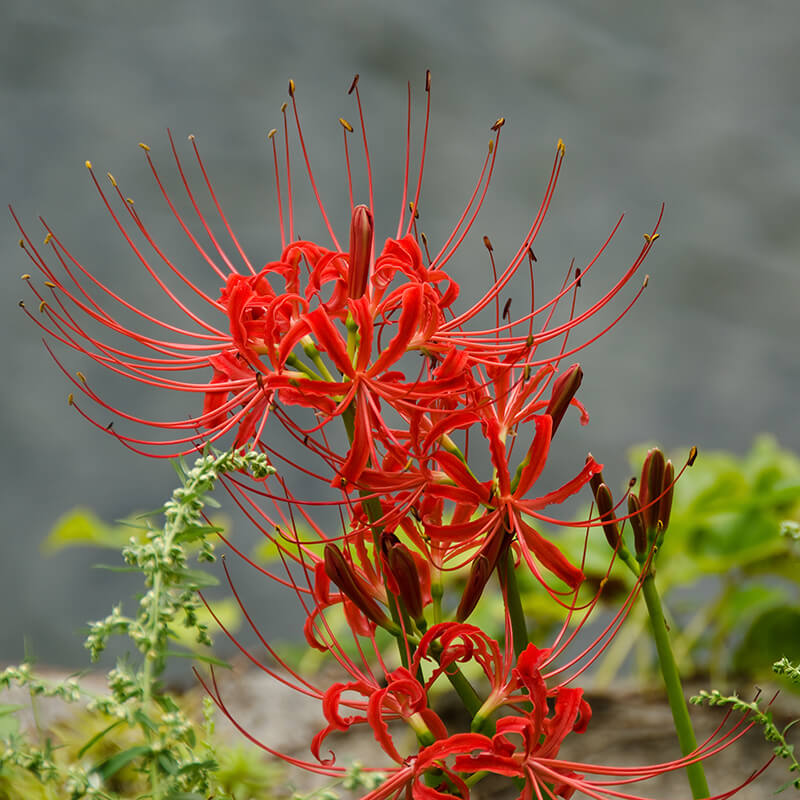
- 🔮 Symbolism: Death, reincarnation
- 💧 Water needs: Average
- 🪴 Soil needs: Average, well-draining
- 🌍 Growing zones: 8 to 10
- ☀️ Light needs: Full sun to half sun
- 🌱 Blooming season: Late summer to early fall
Nerine is a herbaceous perennial plant that grows in the United Kingdom and other temperate regions of Europe. It has long, narrow leaves, usually green with red spots on the upper surface.
Nerine is a herbaceous perennial plant that grows in the United Kingdom and other temperate regions of Europe. It has long, narrow leaves, usually green with red spots on the upper surface. The flowers grow on stalks that can reach up to 6 ft tall. The flowers are white or pink with yellow markings at their base and have five petals. There are also two large sepals at the bottom of each flower.
7. Meadow Blazing Star (Liatris Ligulistylus)
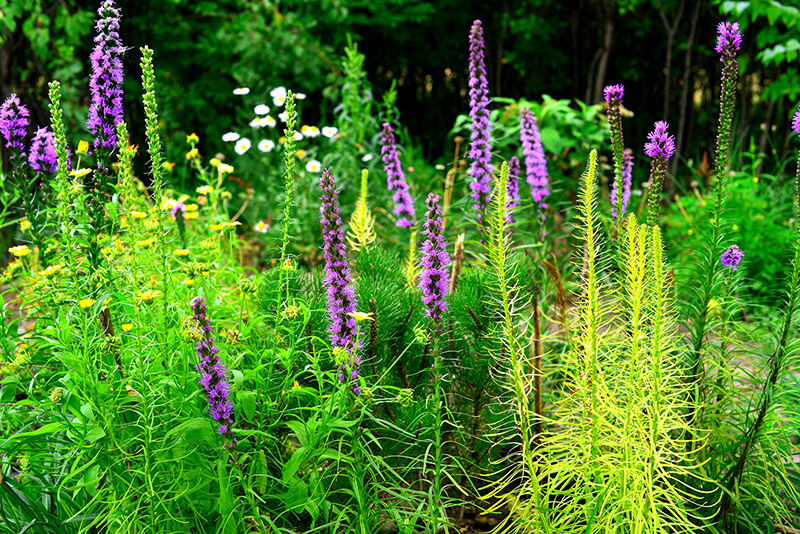
- 🔮 Symbolism: Happiness, joy
- 💧 Water needs: Low
- 🪴 Soil needs: Average
- 🌍 Growing zones: 4 to 8
- ☀️ Light needs: Full sun to partial sun
- 🌱 Blooming season: Late summer
Meadow Blazing Star is a perennial plant that you can find in meadows and fields. It is also known as Liatris spicata.
Meadow Blazing Star produces a red flower in the summertime. The flowers are often called blazing stars because of the way they look at the plant. It has a long stem with many flowers on it, making it stand out among other plants.
The Meadow Blazing Star is not just beautiful to look at but also provides a variety of benefits to those who live nearby. This includes providing food for bees, birds, and butterflies and offering habitats for other plants and animals.
8. Sword Lily (Crocosmia Crocosmiiflora Lucifer)
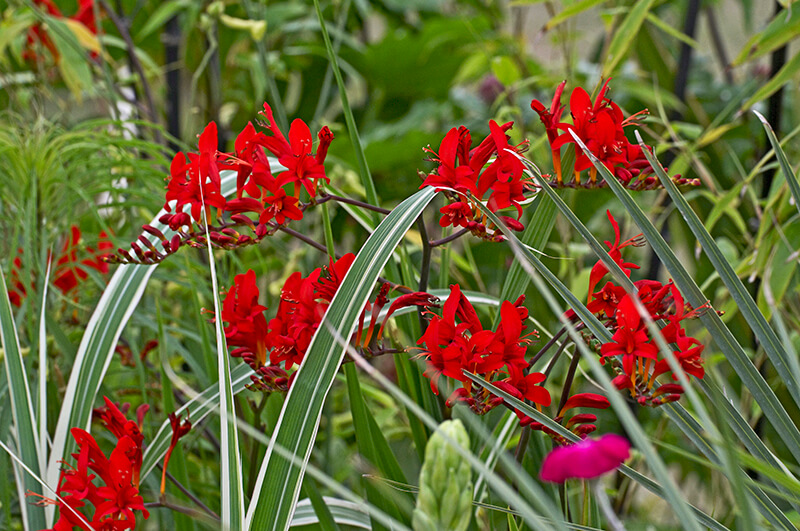
- 🔮 Symbolism: Strength, remembrance
- 💧 Water needs: Average
- 🪴 Soil needs: Sandy, loamy soil
- 🌍 Growing zones: 5 to 9
- ☀️ Light needs: Full sun to partial sun
- 🌱 Blooming season: Spring to fall
Crocosmia is a genus of flowering plants in the Amaryllis family with about 240 species. The most common type of Crocosmia is the Sword Lily, which has sword-shaped flowers that can grow up to three feet long.
The Sword Lily (Crocosmia crocosmiiflora Lucifer) is a perennial herbaceous plant with sword-shaped flowers that grow three feet long. It is native to Europe and Asia and naturalized in North America and Australia. The Sword Lily can be found in many different habitats such as fields, forests, meadows, orchards, hedgerows, and near water sources.
9. Naked Lady (Amaryllis Belladonna)

- 🔮 Symbolism: Self-confidence, pride
- 💧 Water needs: Average to dry
- 🪴 Soil needs: Dry, average, well-draining
- 🌍 Growing zones: 3 to 10
- ☀️ Light needs: Full sun to partial sun
- 🌱 Blooming season: Mid to late Summer
Naked Lady is a type of Amaryllis belladonna found in the wild. It grows from a bulb and produces a single, bare stem with leaves at the top. The plant has been used as an ornamental plant for centuries and is now grown commercially for its bulbs, which are used to make daffodils, narcissus, and other flowers.
10. Saffron Crocus (Crocus Sativus)
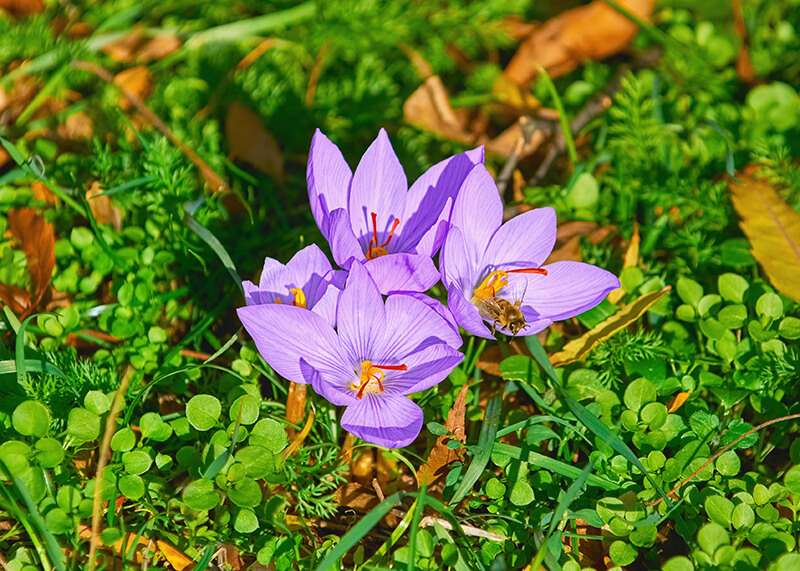
- 🔮 Symbolism: Cheerfulness, joy
- 💧 Water needs: Low
- 🪴 Soil needs: Dry to well-draining
- 🌍 Growing zones: 6 to 10
- ☀️ Light needs: Full sun to half sun
- 🌱 Blooming season: Fall
Saffron Crocus, also known as the saffron, is a flowering plant in the genus Crocus and is used as a spice and dye. It is native to Southwest Asia but now grows in temperate regions around the world.
Saffron Crocus has been cultivated for thousands of years for its use as a food coloring and spice. The flowers are dried and ground to produce the spice saffron used in many dishes such as paella, risotto, rice pudding, soups, stews, and sauces. It can also be used to give colorant or flavor to certain types of bread or rice-based desserts. The flowers are also used whole or ground as coloring or flavoring agents for foods such as yogurt drinks and ice creams
11. Peacock Orchid (Gladiolus Acidanthera)
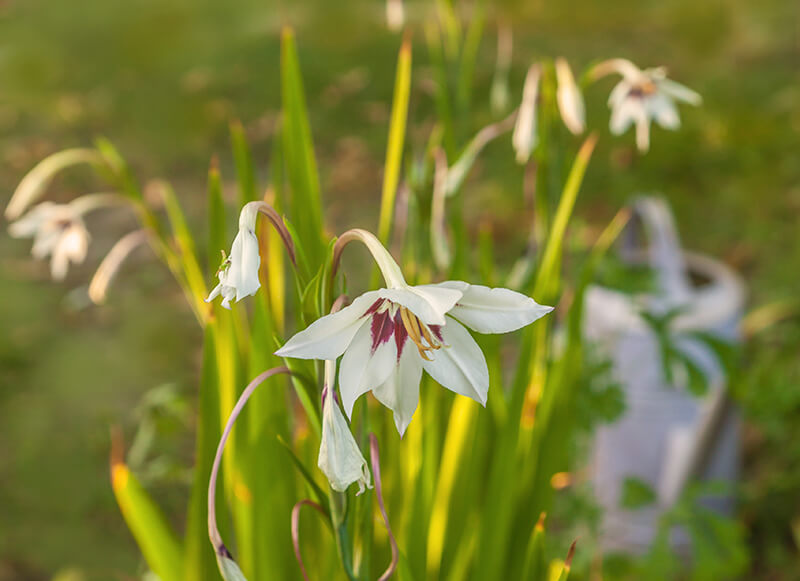
- 🔮 Symbolism: Beauty, dignity
- 💧 Water needs: Average
- 🪴 Soil needs: Sandy, loamy, well-draining
- 🌍 Growing zones: 3 to 10
- ☀️ Light needs: Full sun
- 🌱 Blooming season: Mid summer
The Peacock Orchid is a perennial plant found in the tropical and subtropical regions of Asia, Africa, Australia, and the Americas. It is a member of the lily family and has leaves that are 6-12 inches long and 0.8-2.5 inches wide.
The Peacock Orchid has been known to have medicinal properties with regard to pain relief, stress reduction, appetite stimulation, and even as a treatment for epilepsy.
The peacock orchid is an ideal plant for anyone who wants to live green because it does not require much care or maintenance.
12. Richard Wallace Canna Lily (Canna Richard Wallace)

- 🔮 Symbolism: Glory
- 💧 Water needs: High
- 🪴 Soil needs: Loamy, wet, well-draining
- 🌍 Growing zones: 2 to 10
- ☀️ Light needs: Full sun
- 🌱 Blooming season: Mid summer/li>
The Richard Wallace Canna Lily flower is a cool hybrid plant known for its large, fragrant, and sweet-smelling flowers. The Richard Wallace Canna Lily is a flower discovered in the United States. It is a hybrid of the canna lily and the lily of the valley. The flower has purple petals with silver-white stripes on them.
The Richard Wallace Canna Lily flower was created by the American botanist and horticulturalist Richard Wallace in 1885. The plant’s name comes from its creator’s last name. The first hybrids of this plant were created by Wallace in 1884.
The flowers are usually white or cream with pink or red tinges on their edges, which can be up to three inches wide and have an eye-catching pattern on the petals.
13. Guernsey Lily (Nerine Bowdenii)

- 🔮 Symbolism: Freedom, good fortune
- 💧 Water needs: Average
- 🪴 Soil needs: Loamy soil
- 🌍 Growing zones: 3 to 10
- ☀️ Light needs: Full sun to partial shade
- 🌱 Blooming season: Summer
Also known as Jersey lily, the Guernsey Lily is a plant in the genus Nerine. It is a perennial plant that grows in the northern hemisphere. This plant has been used in herbal medicine for centuries, and it is still used today as a folk remedy for many disorders, including diabetes, cancer, and arthritis.
These types of bulb flowers are typically white but can be pink or purple with purple markings on the petals and sometimes have yellow spots on them. They bloom from April to June.
14. Pink Rain Lily (Zephyranthes robusta Pink)
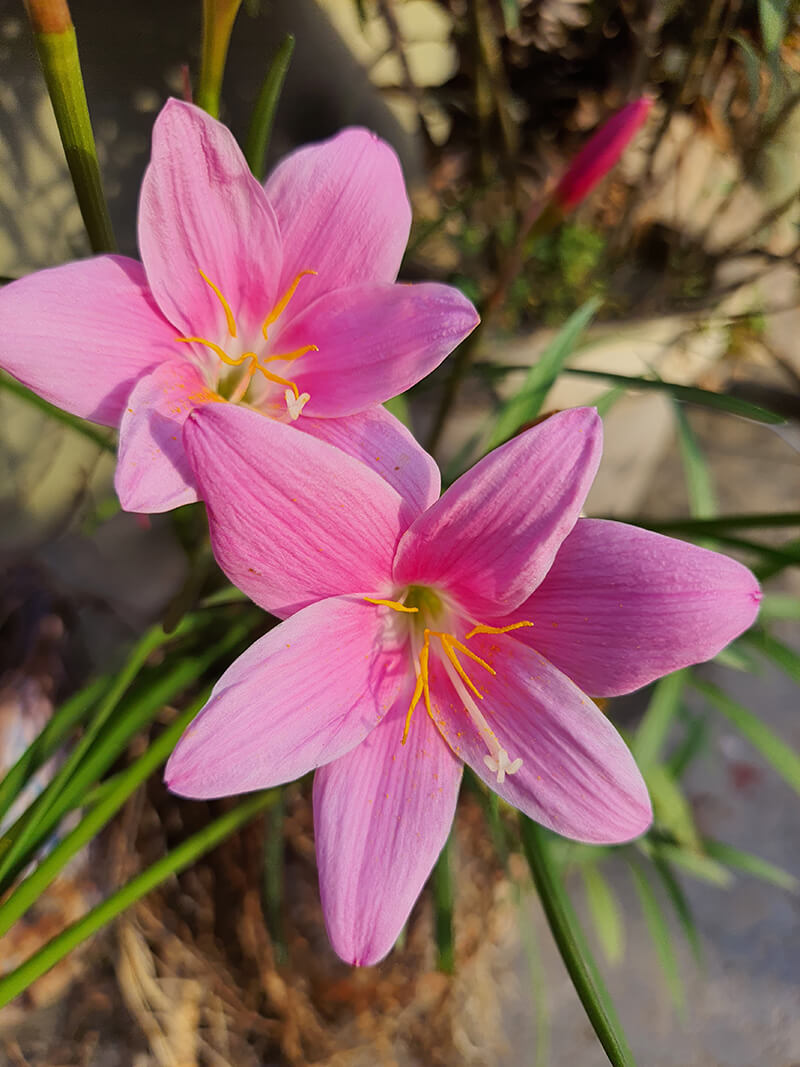
- 🔮 Symbolism: Rebirth, new beginnings
- 💧 Water needs: Average to high
- 🪴 Soil needs: Average, well-draining
- 🌍 Growing zones: 3 to 10
- ☀️ Light needs: Full sun to partial shade
- 🌱 Blooming season: Mid to late summer
Zephyranthes robusta Pink is a type of perennial plant. It is also called the pink rain lily. It is native to South America and has been introduced to other countries.
The Zephyranthes robusta Pink flower has a long, tubular perianth tube that can grow up to 8 inches in length. The flowers bloom in shades of pink and are generally blooming from May to June.
The Zephyranthes robusta Pink plant grows up to 3 ft tall and has green leaves with white spots on them. The leaves are arranged in opposite pairs on the stem.
15. Canna Lily (Canna Happy Cleo)
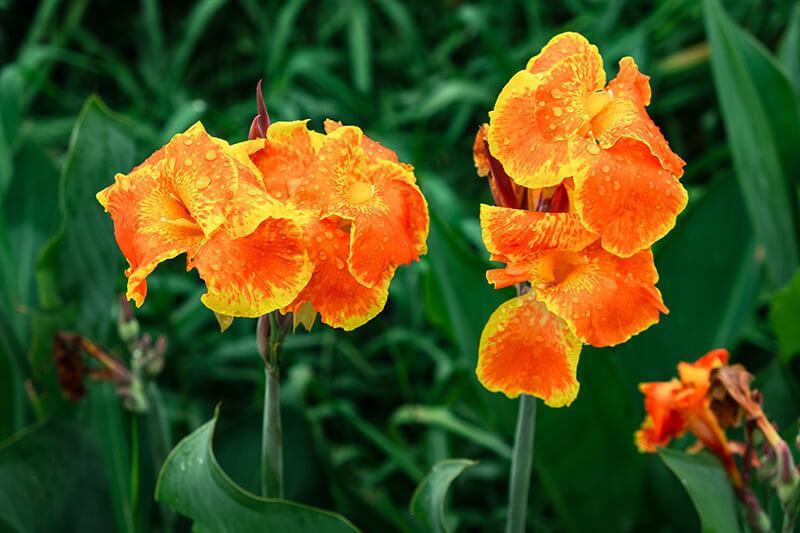
- 🔮 Symbolism: Glory, power
- 💧 Water needs: Average to high
- 🪴 Soil needs: Average to moist
- 🌍 Growing zones: 3 to 10
- ☀️ Light needs: Full sun to partial shade
- 🌱 Blooming season: Summer
The Canna Lily is not a common sight in most gardens. It blooms late and only for a few weeks.
Canna Lily is an annual plant that can grow up to 3 feet tall and has small white flowers with purple stripes. It is native to tropical regions of Africa, Asia, and America but can be found in some greenhouses.
Some people have successfully grown them by taking cuttings from their parent plants or by starting seedlings indoors and transplanting them outside when they are large enough.
16. White Camassia Lily (Camassia Leichtlinii Alba)
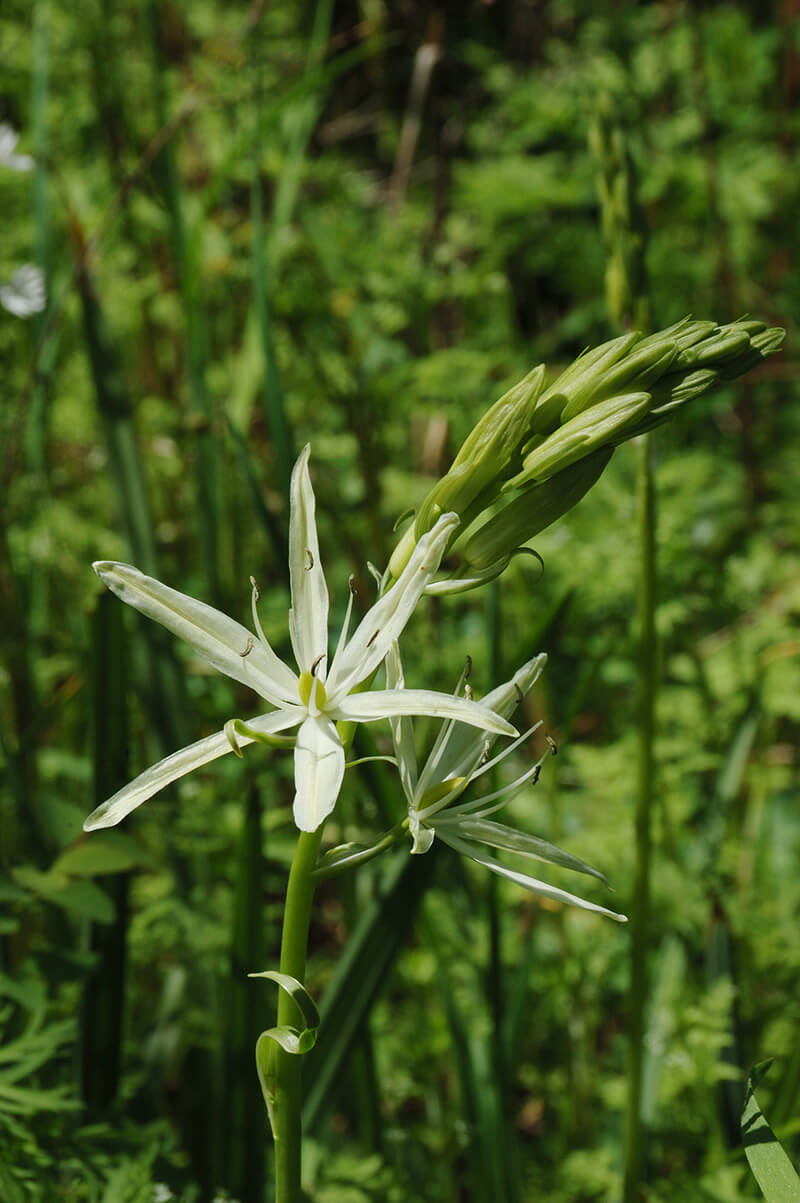
- 🔮 Symbolism: Purity
- 💧 Water needs: High
- 🪴 Soil needs: Moist, clay, loamy, well-draining
- 🌍 Growing zones: 2 to 8
- ☀️ Light needs: Full sun to partial shade
- 🌱 Blooming season: Late spring to early summer
White Camassia Lily is a perennial plant that is native to the eastern U.S. It has white flowers and grows in moist, rich soils of bogs and marshes.
Camassia leichtlinii is a white camassia lily from the genus Camassia, which is in the Lily family. The genus name comes from the Greek word for “beautiful,” named by Carl Linnaeus in 1754.
17. Double Scarlet Begonia (Begonia Double Scarlet)
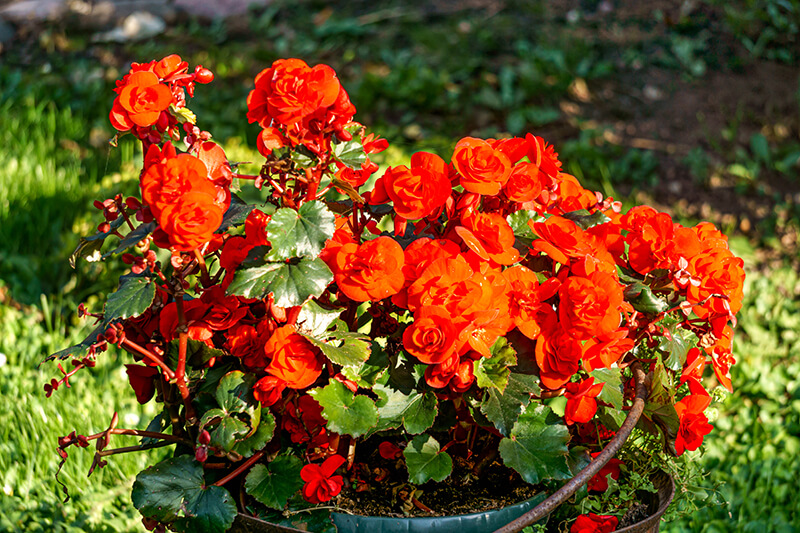
- 🔮 Symbolism: Caution
- 💧 Water needs: Average
- 🪴 Soil needs: Sandy, loamy
- 🌍 Growing zones: 3 to 10
- ☀️ Light needs: Half sun
- 🌱 Blooming season: Mid summer
Double Scarlet Begonia is a bicolored begonia that flowers in shades of red and white.
Double Scarlet Begonia is an attractive plant with a unique flower. It is an excellent choice for both indoor and outdoor use. It can be grown in pots or on the ground, but it must be watered regularly to ensure that it doesn’t dry out.
18. Black Beauty Gladiolus (Gladiolus x Hortulanus ‘Black Beauty’)

- 🔮 Symbolism: Remembrance
- 💧 Water needs: Average
- 🪴 Soil needs: Sandy, loamy
- 🌍 Growing zones: 3 to 10
- ☀️ Light needs: Full sun to partial sun
- 🌱 Blooming season: Mid summer
Black Beauty Gladiolus (Gladiolus Black Beauty) is a hybrid of Gladiolus and Black Beauty. These types of bulb flowers have a dark purple flower with a white background.
It was created by Alyssa Gartner, who is an artist and horticulturalist from New York City. She wanted to create something unique and beautiful, so she combined these two plants to create this hybrid plant.
Alyssa Gartner’s goal was to create something that would be popular among gardeners but also have an aesthetic appeal to it.
19. Crown Imperial Yellow (Fritillaria Lutea)
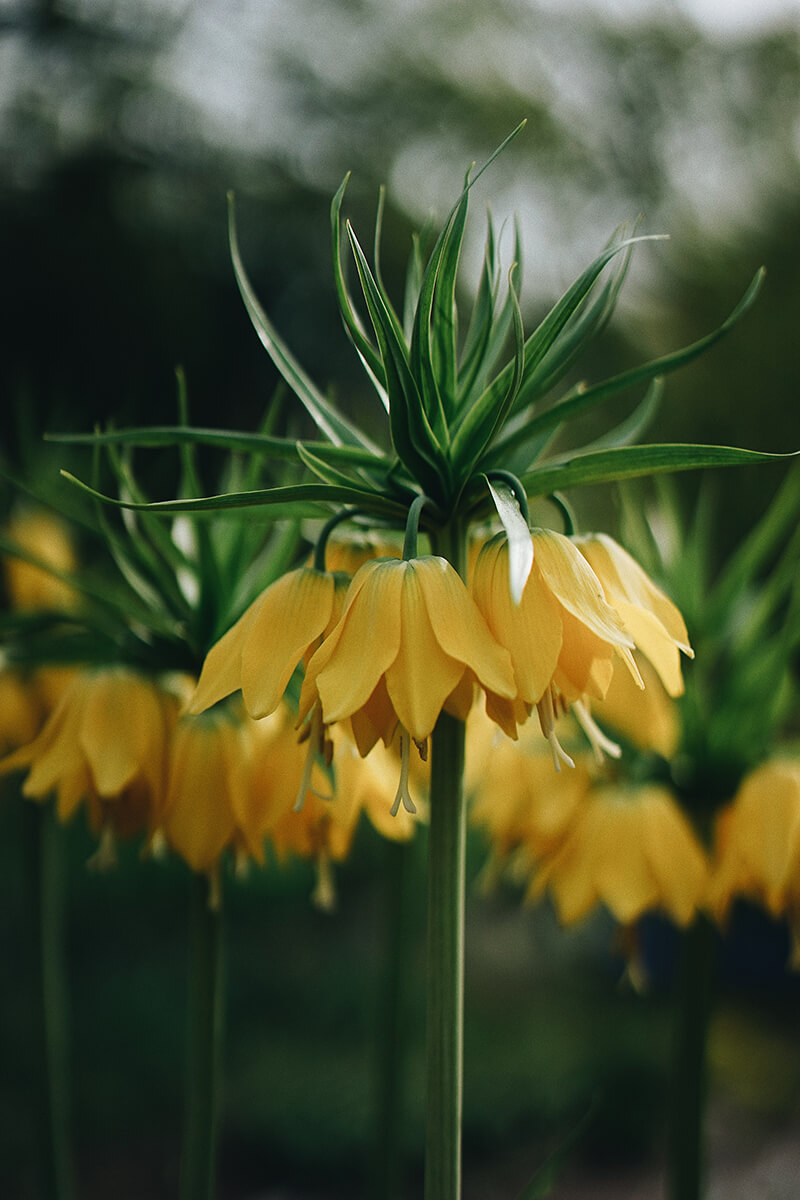
- 🔮 Symbolism: Royalty, legitimacy, power
- 💧 Water needs: Average
- 🪴 Soil needs: Loamy
- 🌍 Growing zones: 3 to 10
- ☀️ Light needs: Full sun to half sun
- 🌱 Blooming season: Mid spring
Crown Imperial Yellow is a type of fritillaria that grows in the spring. It has been used as a medicinal plant in China and has been used as a traditional remedy for stomach problems, dysentery, and inflammation.
The flowers of this plant are yellow with purple spots and are most often found in wet places like swamps, marshes, streams, or ditches. They have been known to grow up to 6 feet tall.
20. Crocosmia Emberglow (Crocosmia Crocosmiiflora)
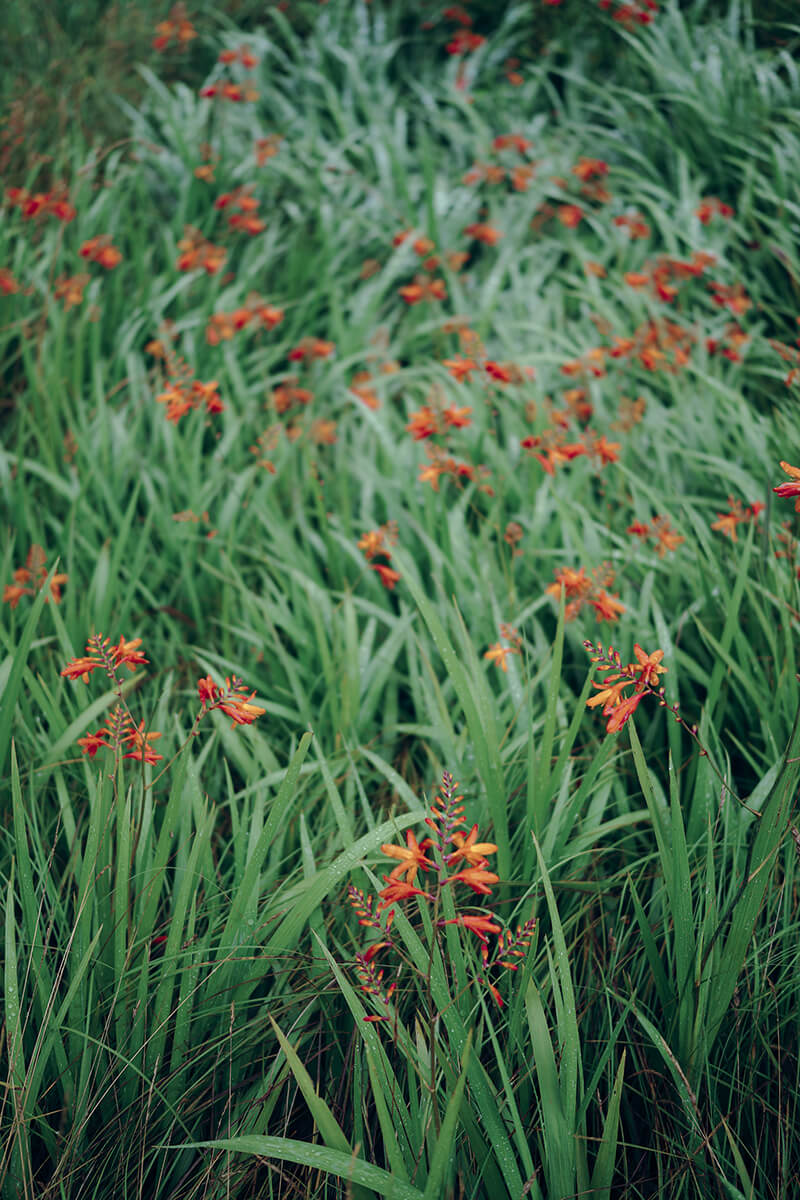
- 🔮 Symbolism: Confidence, feelings of love, deepest emotions
- 💧 Water needs: Average
- 🪴 Soil needs: Sandy, loamy
- 🌍 Growing zones: 6 to 9
- ☀️ Light needs: Full sun to partial sun
- 🌱 Blooming season: Mid to late summer
Crocosmias are types of bulb flowers that are beautiful flowering plants found in temperate areas of the world. It has beautiful flowers and leaves.
The Crocosmia Emberglow is a cultivar of the crocosmia plant with an intense, fiery orange flower coloration. This cultivar was created by crossing two other cultivars, the Crocosmia Brilliant Star and the Crocosmia Sunrise Surprise.
21. Stargazer Oriental Lily (Lilium Orientalis Stargazer)
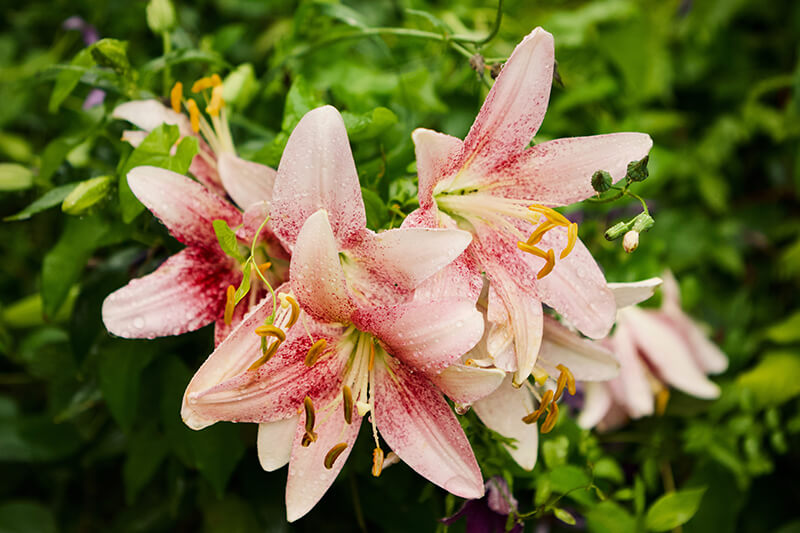
- 🔮 Symbolism: Perfection
- 💧 Water needs: Average
- 🪴 Soil needs: Loamy
- 🌍 Growing zones: 4 to 9
- ☀️ Light needs: Full sun to half sun
- 🌱 Blooming season: Mid to late summer
The Stargazer Oriental Lily (Lilium orientalis Stargazer) is a species of lily native to the temperate regions of central Asia.
The name “Stargazer” comes from the flower’s ability to open its petals in a star-like pattern at night and close them during the day. This helps it avoid predators that might see it as a threat during the day.
The Stargazer Oriental Lily (Lilium orientalis Stargazer) has been used for ornamental purposes but is also grown as a food crop in some areas, including China and Japan.
Stargazers are commonly used in gardening because they require little care and can be planted in pots or mixed into beds.
22. Flowering Onion (Allium Giganteum)
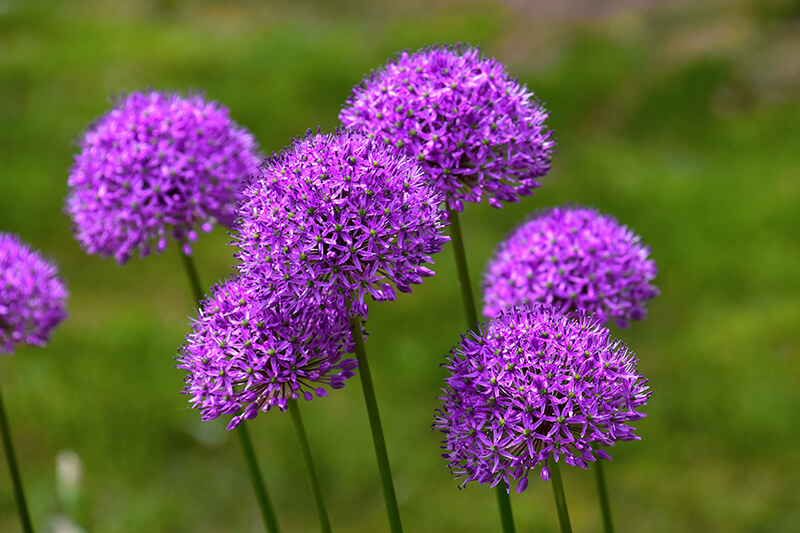
- 🔮 Symbolism: Good fortune, unity, patience
- 💧 Water needs: Average to dry
- 🪴 Soil needs: Loamy
- 🌍 Growing zones: 4 to 9
- ☀️ Light needs: Full sun to half sun
- 🌱 Blooming season: Late to early Summer
The Flowering Onion is a bulbous plant that grows from the ground and has a flower with an onion-shaped head. The flowers are a beautiful shade of light purple and grow on long, thin stems.
Allium giganteum is one of the most unusual plants. It flowers form an onion ball. It is also one of the tallest flowering plants globally, with its height reaching up to 10 feet!
The Flowering Onion has been around since ancient times and was even used by ancient Egyptians as a symbol of eternal life.
23. Tiger Flower (Tigridia Pavonia)
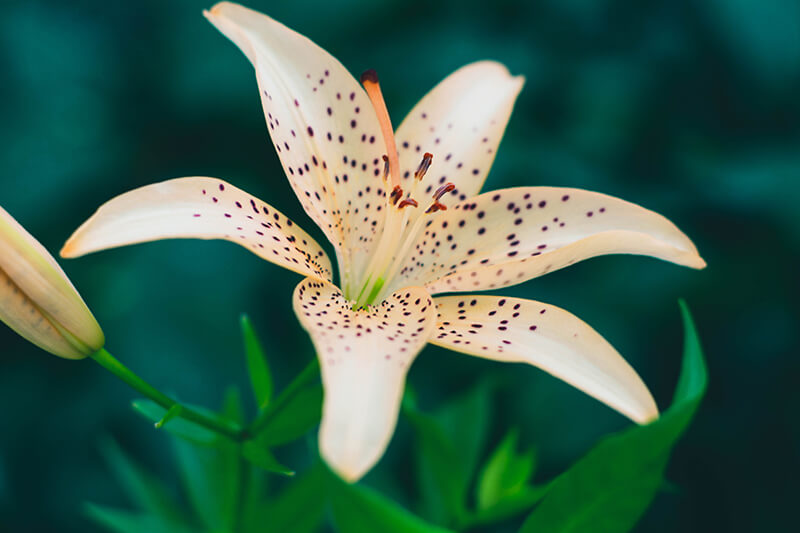
- 🔮 Symbolism: Cruelty
- 💧 Water needs: Average to dry
- 🪴 Soil needs: Sandy, loamy, dry
- 🌍 Growing zones: 3 to 10
- ☀️ Light needs: Full sun to partial sun
- 🌱 Blooming season: Mid to late summer
The Tigridia is a plant in the Orchidaceae family that is native to Mexico. It is also called Mexican Shelfllower because it grows on the underside of trees and rocks like a shelf.
The Tiger Flower is a cool plant that has been in the spotlight recently due to its popularity as a houseplant. The Tiger Flower is an interesting plant that has been in the spotlight recently due to its popularity as a houseplant.
24. Peruvian Daffodil (Hymenocallis Festalis)
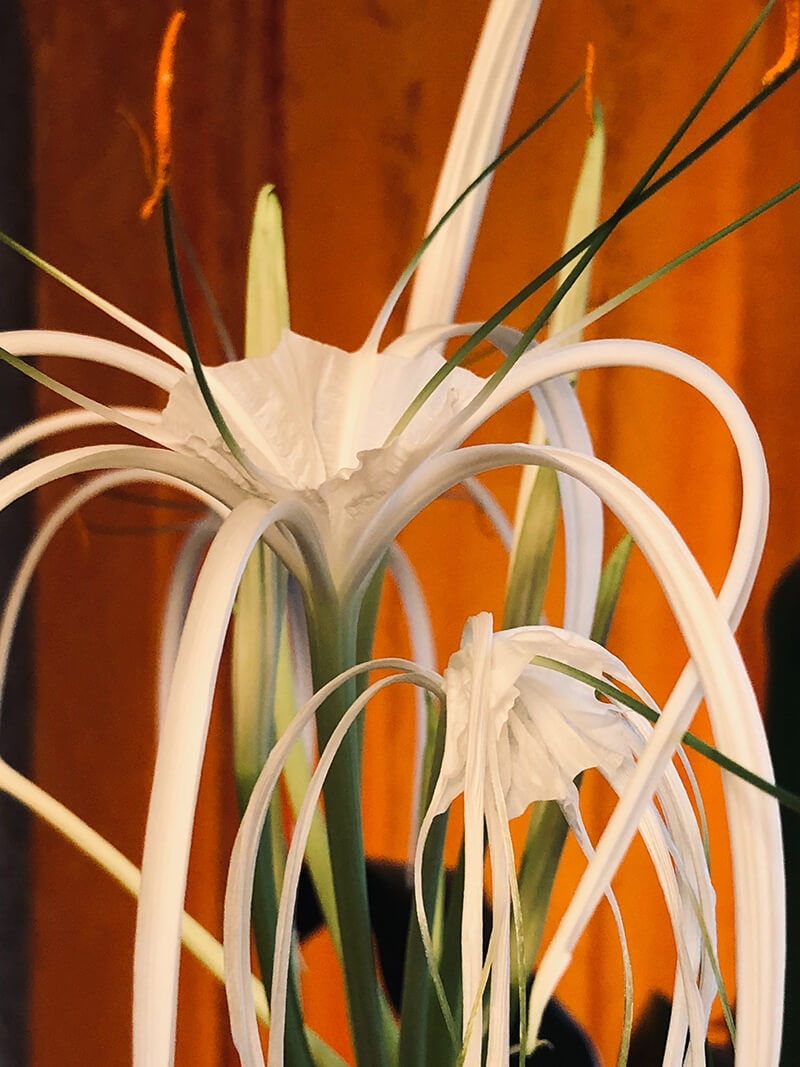
- 🔮 Symbolism: Festive, bright
- 💧 Water needs: Average to high
- 🪴 Soil needs: Loamy to well-draining
- 🌍 Growing zones: 3 to 10
- ☀️ Light needs: Full sun to half sun
- 🌱 Blooming season: Early to mid-summer
The Peruvian Daffodil, also known as the White Daffodil, is a perennial bulbous herbaceous flowering plant in the Amaryllis family native to Peru. The flower’s white petals are densely packed with pollen and are often seen in large quantities on the flowers’ surface. These flowers bloom from January through March, which makes it difficult to cultivate them in other countries outside of Peru.
The Peruvian Daffodil is an incredibly beautiful flower with a unique history that has made it into a national treasure of Peru. The flower’s history dates back to before the Inca Empire and was used by Incan women as a natural contraceptive or abortifacient.
25. Care to Dance Bearded Iris (Iris Germanica ‘Care to Dance’)
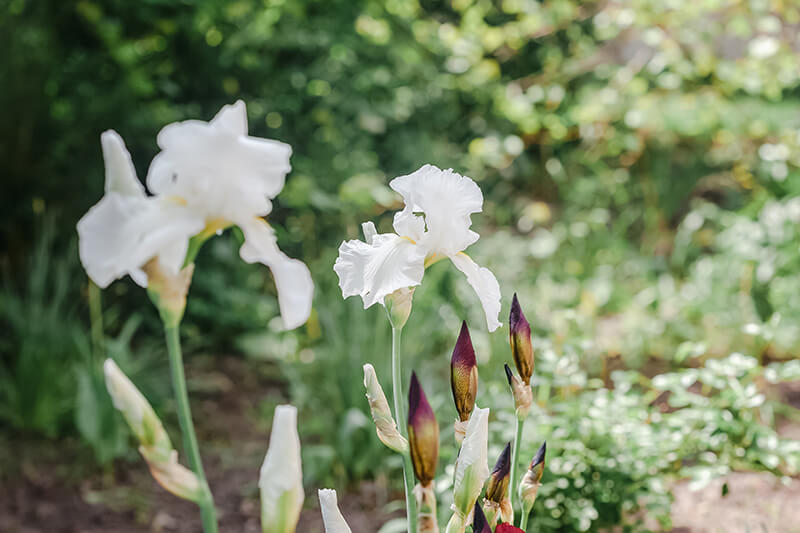
- 🔮 Symbolism: Faith, hope
- 💧 Water needs: Average to low
- 🪴 Soil needs: Sandy, loamy, clay, average
- 🌍 Growing zones: 3 to 9
- ☀️ Light needs: Full sun
- 🌱 Blooming season: Mid spring
Care to Dance Bearded Iris is an annual plant that blooms in the spring. It has a long, bearded stem and a cluster of yellow flowers.
Iris germanica ‘Care to Dance’ is an annual plant that blooms in the spring. It has a long, bearded stem and a cluster of yellow flowers. The name comes from the fact that it starts dancing when you touch it with your fingers.
The flower is also known as the dancing iris because it starts moving when you touch its leaves or stems with your fingers or hands.
This plant is native to Europe and Asia but can be found around the world in temperate regions where summers are warm with moderate rainfall.
26. Nori Gladiolus (Gladiolus Nori)
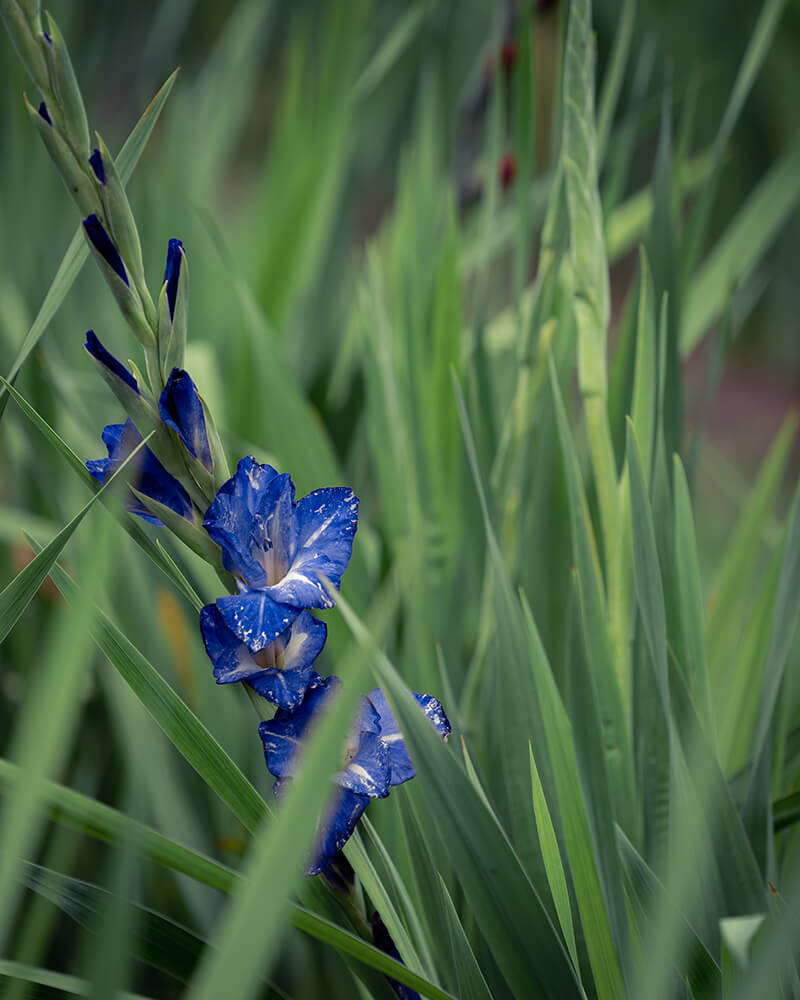
- 🔮 Symbolism: Strength, strong character
- 💧 Water needs: Average
- 🪴 Soil needs: Sandy, loamy
- 🌍 Growing zones: 3 to 10
- ☀️ Light needs: Full sun
- 🌱 Blooming season: Mid summer
Gladiolus Nori is a plant that is native to the Mediterranean region. It was first introduced into Europe in the late 1800s and has since grown in popularity. Nori Gladiolus is a plant that is native to the Mediterranean region. It was first introduced into Europe in the late 1800s and has since grown in popularity.
The plant’s blooms are usually white or yellow, depending on what type of Gladiolus it is, but they can also be pink or purple. The flowers are usually between six inches and two feet wide, but some can reach up to five feet across. The first use of Nori Gladiolus was as a decorative flower for gardens and bouquets due to its beautiful blooms, but it quickly became popular as an ornamental plant.
27. Orange Daylily (Hemerocallis Fulva)
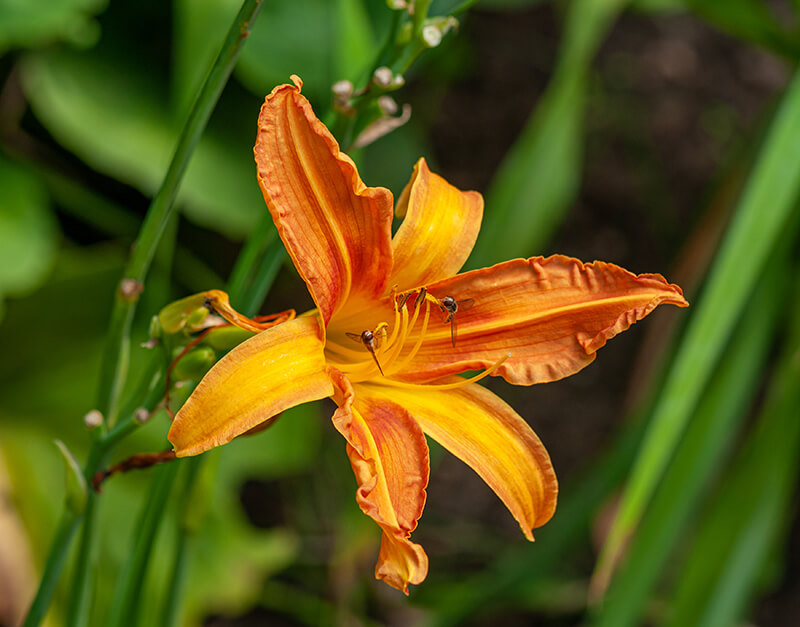
- 🔮 Symbolism: Passion
- 💧 Water needs: Low water needs
- 🪴 Soil needs: Loamy, clay, dry
- 🌍 Growing zones: 2 to 9
- ☀️ Light needs: Full sun to half sun
- 🌱 Blooming season: Early summer
Orange Daylily is a native plant of North America. It has flowers that are orange in color and has a long history of use in North America.
The flower is used for ornamental purposes as well as food. In the past, it was also used for medicinal purposes.
The flower also has a long history of use in North America. It is native to the United States and Canada, but it can be found in other parts of the world as well. The flower is known for its characteristic scent that attracts pollinators like bees, butterflies, and hummingbirds.
27 Most Beautiful Types of Bulb Flowers
Bulb flowers are the perfect plant for beginners to grow in their homes or offices. They’re also a great option for those who want to enjoy beautiful indoor plants without the hassle of caring for them.
Growing a bulb flower plant is also a good way to save money on gardening supplies as you need only one type of plant, soil, and light source. The bulbs will help add some color and life to your home or office space with minimal effort on your part!
